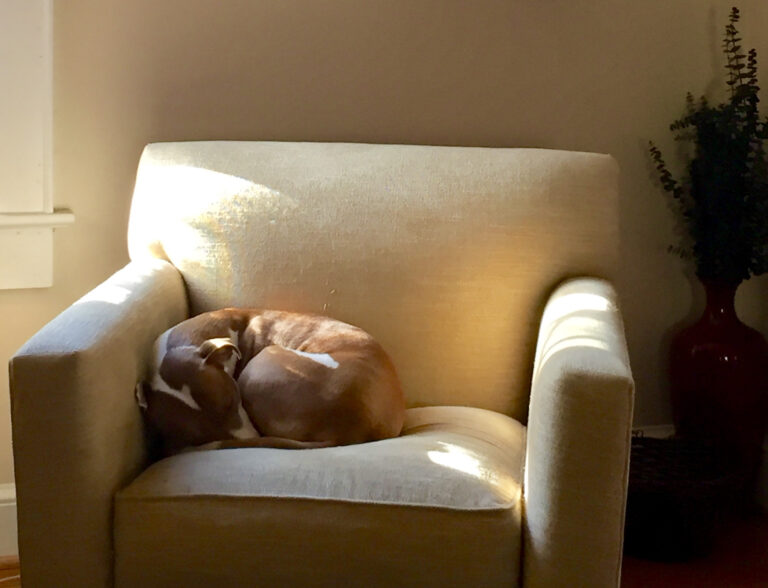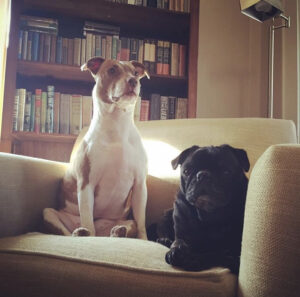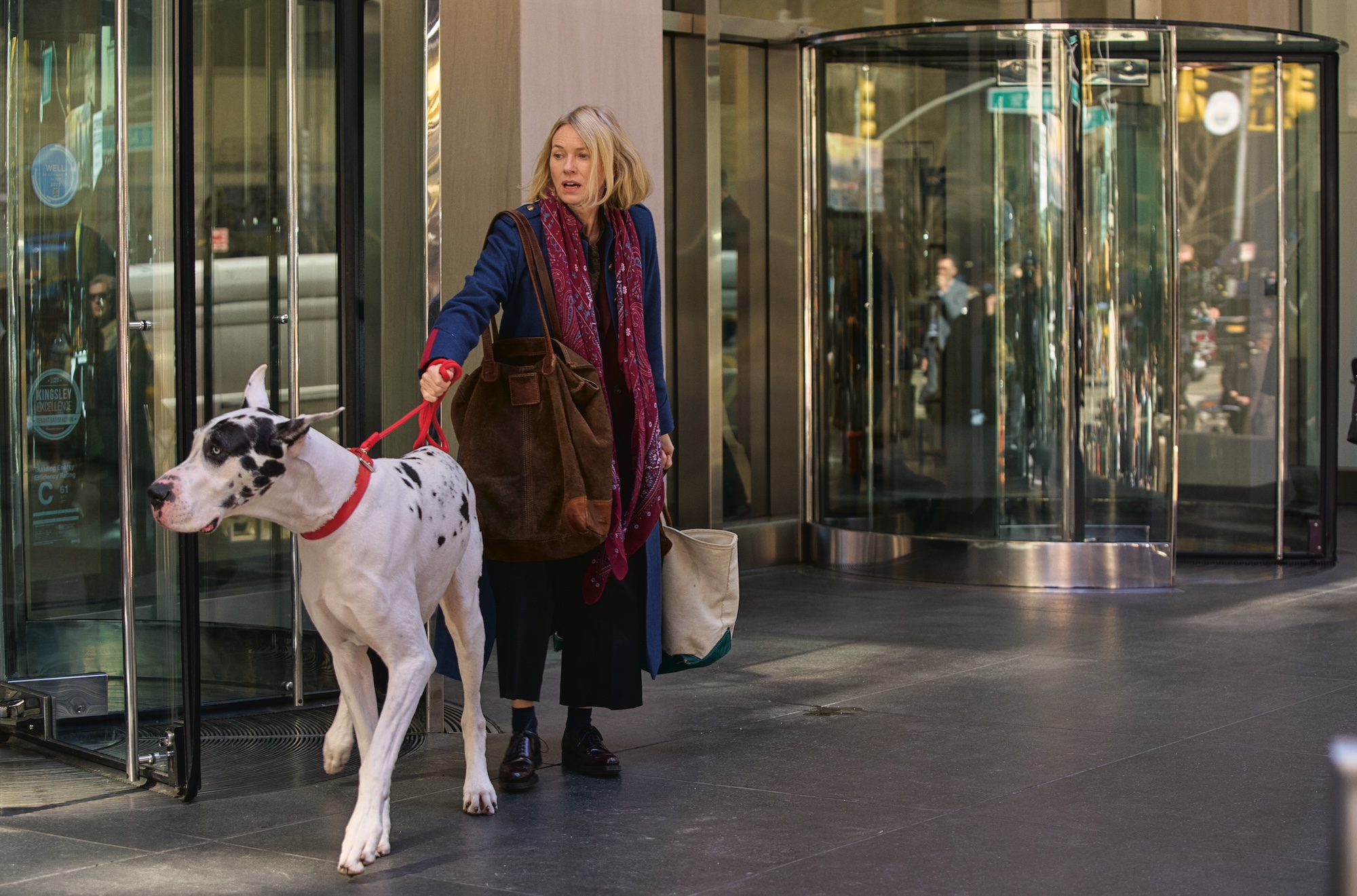In 2008 journalist Bronwen Dickey met a dog named Angel who caused her to rethink everything she previously thought about pit bulls. For Dickey, and many others, a stocky, block-headed dog like Angel represented something to be feared—a “demon dog.” But Angel, who belonged to a friend, wasn’t fearsome at all. She was a good dog. With her expectations confounded, Dickey decided to do some research on the topic of pit bulls.
It’s not surprising that Dickey, a contributing editor at the Oxford American, and a prolific journalist who has contributed to The New York Times, Esquire, Newsweek, Popular Mechanics, Slate, and many other publications, would dive deep into her chosen topic. But this research project would end up spanning seven years and culminate in a critically acclaimed book, Pit Bull: The Battle Over an American Icon. In the process Dickey and her husband also adopted a pit bull they called Nola,
Nola, the dog, was another counterpoint to the “vicious pit bull” legend. Pit Bull, the book, published in 2016, is a meticulously researched page turner that weaves together history, science, statistics, sociology, and popular culture to reveal the truth about pit bulls and how they became a breed apart. Dickey chronicles 250 years of pit bull history, from the origins of the breeds that fall under this banner, and their grim service in the fighting pits of London and New York, to their role as a beloved American icon in the early 20th century, and later, as public enemy number one.
While she presents ample science to dismantle many of the enduring (and frankly silly) claims about pit bulls (that they have, for example, locking jaws and a “shark-attack” biting style), Dickey didn’t set out to be a pit bull advocate, or to convince anyone of pit bulls’ inherent goodness. Both pit bull lovers and phobics will find something in the book that challenges their assumptions. In the end, though, the book makes it clear that pit bulls themselves aren’t bad actors, or bad dogs; rather they’ve been the victim of bad science, sloppy journalism, media sensationalism, and human prejudice. As one source tells Dickey in the book, “as long as there are different classes of people, there will be different classes of dogs.”
Dickey took the time to talk to us about her own history with dogs, her pit bull journey, our often unrealistic expectations of dogs, and Nola.
Digest: First, how is Nola?
BD: She’s doing well! Though now that she’s almost eleven, she’s slowed down quite a bit. She spends most of her days on the couch, and she right now seems to be enjoying quarantine much more than I am.

You were a dog owner before Nola—did you consider yourself a dog person? What was your relationship with dogs growing up?
Our family had many dogs when I was growing up—probably too many. Both of my parents struggled with addiction, which often meant that, as much as we loved our pets, they did not get the care and attention they needed. That was a source of great shame for me as a child, but it helped me understand the plight of others across the country who deeply care about animals, but don’t have the information or resources they need to provide for their pets in the way they want to. In many cases, animal suffering arises from human suffering, and you can’t effectively deal with one without dealing with the other.
After I graduated from college, I decided to give myself another shot as a dog owner. I spent the next 13.5 years sharing my life with a highly-opinionated pug named Oscar, who was the most patient sidekick I could have ever asked for. A year after I married my husband, we decided to add a local shelter dog to the pack, and that’s when we met Nola.
Why did you choose a pit bull—why did you choose Nola? Did you just see a dog, versus seeing a pit bull? Were you aware of just how fraught the whole business is/was?
Since I grew up in the 1980s at the height of the pit bull panic, I never thought I would end up adopting one. I had seen too many news clips of terrifying “demon dogs” to see them as anything but dangerous. That changed in 2008, when I met a friend’s adopted pit bull, who was incredibly friendly, affectionate, and easy-going. Because that experience contradicted everything I’d been told about how “unpredictable” and “savage” these dogs were, I started researching the history of pit bulls in America, as well as the science of dog behavior and the epidemiology of dog-bite injuries, and discovered that a lot of the most common claims about this large, diverse group of animals were simply not true.
When my husband and I decided to adopt a shelter dog in 2010, we knew that the most common type of dog in our community were the ones labeled “pit bulls.” (I say “labeled as” because many of these dogs are actually mixed breeds that were picked up as strays, not purebreds from one of the four pit bull breeds: American Pit Bull Terrier, American Staffordshire Terrier, Staffordshire Bull Terrier, American Bully). We trusted that our shelter wouldn’t put dogs up for adoption unless the staff were confident they would make good pets, so we just chose the dog who we had the strongest connection with. That was Nola.
We humans tend to overgeneralize with dogs—especially based on what they look like—so I’m always careful to point out that we could have met three dozen “pit bulls” that day and not clicked with any of them. But we happened to meet this one dog who was very smart, very sweet, and had a “spark” that made her stand out from the others.
I knew from my research that the whole business of pit bulls was fraught, but I had no idea how fraught. Suddenly, I had to think about where my dog could or couldn’t go, and everyone in my life had an opinion!

How would you describe Nola’s role in your life?
Oscar died in 2017, which was incredibly hard. The story of Oscar was the story of my whole adult life, in a lot of ways. But he was a bit more aloof than Nola is. Nola is much more relational: she picks up on things faster, she’s more expressive, and because she’s a bit bigger, she’s easier to do things with. Like all dogs, she also has her limits—she’s frightened by crowded, noisy places, for example, and starts to shake when she’s scared—so I’ve learned not to push her into situations that make her uncomfortable. Why should she have to go to a street fair or something if it totally freaks her out? So we look out for each other. It’s a partnership, a give-and-take.
I work from home, and it’s wonderful to have such a cheerful, snuggly companion with me during the day, reminding me when it’s time to take a break and walk around the neighborhood, especially these past few months. Nola’s sense of time is a little eerie—she knows our schedule, down to the minute!
What made you want to write a book about pit bulls? You’re a writer/journalist and weren’t specializing in dogs per se. Obviously getting Nola played a role. But writing a book is a huge decision and commitment. What drove that decision?
Finding a book subject is a bit like falling in love: sometimes it hits you when you least expect it. I had never been interested in writing about domestic animals or pets before, but the historical trajectory of pit bulls, and all the mania surrounding them, allowed me to explore many other topics that intrigued me. There are lots of social reasons why our species is so hung up on dog breeds and dog breeding; we see dogs as an extension of ourselves, and that comes with a lot of baggage. To understand that, you have to examine race, class, politics, fear, economic inequality, stigma, symbolism, media hype, scientific literacy, etc. At a certain point, I found myself obsessed with all the ways that this one shape of dog illuminated much larger trends in American society. As my research files grew, I knew it couldn’t be summarized in one magazine story, and there was a lot more to dive into.
How intense was the reaction from the anti-pit bull faction?
Oof, yes! That was a sad time. There is a small-but-vocal contingent of people who believe that all dogs of this vague shape should be banned and/or eradicated, and they claim to be advocates for the victims of dog-bite injuries. Unfortunately, most of their “activism” involves harassment and online trolling. Throughout 2016 I had to deal with a wave of ugly messages, threats, and attacks on social media that resulted in one guy showing up to one of my readings and causing such a commotion that the store had to call the police. After that, my publisher requested security for my events, and we upgraded our alarm system to include cameras.
The strangest thing about that harassment campaign is that the critics seemed to be upset about things I never said and points I wasn’t making. I don’t consider myself a “pit bull advocate,” and I didn’t write the book to entice people to adopt pit bulls, nor do I subscribe to the positive myth-making that has occasionally bubbled up in response to the fear-based pit bull myths. I don’t think these dogs are better, smarter, more loving or loyal pets than dogs of any other type. The point of the book is to unpack a long, complicated social history and to highlight the importance of seeing dogs as individuals.
I’m deeply sympathetic to anyone who has been injured by a dog, and I think people who have had terrible, traumatic experiences with dogs should have more legal recourse in our system than they currently do. After speaking with many veterinary behaviorists, dog trainers, animal control officers, and shelter workers, I also firmly believe that breed-neutral dog-bite prevention measures are essential for public health, and I wish that public schools made the issue of dog safety a regular part of their early childhood education health programs.
While there’s no evidence that singling out one shape of dog for special restrictions makes the public safer, we all need to consider that dogs see the world in a much different way than we do, and they may be stressed in ways we aren’t picking up on. When we don’t pay attention to those stressors, bites and injuries can happen. Fifty years ago, pet dogs were only expected to live in houses or yards and go for walks around the neighborhood. Now we take them to dog parks, bars, restaurants, outdoor concerts, shopping centers, airports, train stations, etc. and bombard them with new faces and sensory stimuli they might not enjoy as much as we do, especially if they aren’t used to it. Alexandra Horowitz’s excellent book Inside of a Dog, Jean Donaldson’s The Culture Clash, and Patricia McConnell’s The Other End of the Leash really helped me understand that.
That said, I think it’s important to support the survivors of trauma in whatever way we can and find breed-neutral, evidence-based ways to address their concerns. That’s part of building more inclusive communities for all people and pets.
Other dogs, at various points throughout history, have been “targeted” by people driven by fear (like Rottweilers). In one chapter you talk about how the spitz dog was targeted as the breed thought to be responsible for spreading rabies. The New York Times quote in the book equating the spitz with the deadliest snakes is almost beyond belief. But you say that, other than the wolf, the level of collective fury that has been directed against this one group of animals is unprecedented. What is it about the pit bull that draws out this extreme reaction in people?
As you mentioned, these panics around certain breeds or shapes of dogs are cyclical, but the pit bull panic hit in the late 1970s-early 1980s, when crime was rising, unemployment was high, cities were losing resources, and there was a giant shift in the way Americans consumed their media. The 1980s, especially, was rife with fear-based media narratives about how much society was breaking down and how people were turning on each other, many of which—“stranger danger,” “road rage,” the widespread “Satanic panic”—turned out to be either pure hype or a total misunderstanding of basic data.
So it’s not surprising that the age-old “killer dog” narrative fit right into this, but this time the dogs weren’t large, visually distinctive breeds like German shepherds or Rottweilers, they were the medium-sized, generic, fairly common dogs of the working-class. While some of these dogs were (and still are) bred for the horrific crime of dogfighting, most of them weren’t, and aren’t. But when you combine a tense social moment with a zealous media, sensational stories can spiral out of control fairly fast.
One of the most striking things about the book is how much the collective feeling about pit bulls is tied up in issues of race. Did you set out knowing this was going to be a book about broader issues of prejudice? Or at what point did that become clear?
Fairly early in my research, when I was simply asking people I met what they thought about pit bulls in general, I was taken aback by how many of them replied with statements about the people they associated the dogs with, rather than discussing the dogs themselves. I kept hearing intensely racialized stuff about “thugs,” “drug dealers,” and “criminals,” which seemed to be the real source of the fear. The pervasive idea was that, even if the dogs themselves were not “bad,” they belonged to “bad” people, and therefore they must be dangerous or otherwise undesirable. So I knew I wanted to explore the social dynamics of that in depth.
The book deals with another timely topic—the difficulty of persuading people to change their minds with facts. Do you have any advice on changing people’s minds about pit bulls (or, you know, other issues…? )
As I always say, you can’t reason someone out of something he/she/they weren’t reasoned into, and I don’t think that shaming anyone for being afraid or cautious is the right approach. Making concerted efforts to “change minds” can lead to what psychologists call a “backfire effect,” causing people to dig their heels in deeper. No one wants to be told what to think or how to feel.
Fear also hijacks the brain, which is important to understand. Before the pandemic, I traveled frequently, but no matter how many airplanes I got on, or how many statistics I read about the safety of air travel, I was still afraid every time. I knew my fear was irrational, but it just did not matter, and if someone had said to me, “You’re an idiot for being scared; what’s wrong with you?” it would have made it so much worse. Kindness and compassion are so important, in this as in all things.
All you can do is allow people who are afraid to have positive experiences with these animals in low-key ways—but only when and if they are ready. For those who are curious about the subject and are looking for reasons not to be afraid, then I hope the history and facts I’ve laid out open a door they can walk through when the time feels right for them. For others, that time may never come, and that’s completely okay.
Have you met anyone who’s changed their minds about pit bulls—from reading the book or anything else?
Yes, many! But I always stress that my job as a journalist is to explore a subject as thoroughly as I can and report back what I found. What I found is much more complicated than “pit bulls are bad” or “pit bulls are good.” It’s a bit like answering the question “What are Americans like?” There are 320 million of us, of all ages, races, ethnicities, faiths, and backgrounds, dealing with completely different challenges on any given day. It depends on which ones you’re talking about!
What I can say is that, for a lot of complex social reasons, we created a fear-based myth around these dogs that isn’t supported by credible science and is far disproportionate to any threat they (or any other type of domestic dog) actually pose.
It’s tempting to say everything about a dog comes down to the owner / to environment. Because of the preconceptions around them, I think people are loath to introduce any biology into thinking about this kind of dog. But many pit bull advocates are very clear that biology does play a role- for any dog (or anyone). What do you think is the most helpful way to understand or deal with pit bulls when it comes to this question of nature vs nurture?
Both nature and nurture always play significant roles in animal behavior, as any behaviorist will tell you. Nothing is “all in the genes” or “all how you raise them.” In the course of my reporting, I met dogs who came through the cruelest possible circumstances and seem to have been completely unfazed, as well as dogs who had all the love/attention in the world from birth and suffered from brain problems that seemed to have been biological or chemical. Compulsive tail-chasing in English bull terriers, for example, is a well-documented phenomenon, as are certain forms of epilepsy in other breeds.
Biology and genetics can be powerful forces in shaping behavior…but they aren’t the only forces.
With this very large, ill-defined group of dogs, people have historically attributed all their behavior to genetics and breeding by “bad owners” with nefarious motives, when in fact a lot of “pit bulls” are mutts from accidental litters. So it’s important not to make assumptions about stuff we simply don’t know, and focus on the known behavior/background of the dog in front of you. Every single one is different, with different personalities and different needs, and the overwhelming majority are living normal lives we’ll never hear about in the news.
What makes a good pit bull owner?
The same things that make a good dog owner/parent in general! Find a dog you click with, that works for your personality, energy levels, and lifestyle, regardless of whether or not he or she looks like the picture you had in your mind. Learn what your dog needs. Spend as much time with him/her as you can. Don’t let him/her become a nuisance to others. Be patient.
And never, ever forget to have a lot of fun.




